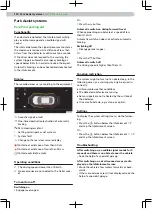
Stop the charging process at the charging station
›
At the end of the charging process, follow the in-
structions at the charging station.
Charging with alternating current (AC) is also ended
by pressing the button on the key. In this case, fur-
ther steps could be necessary to end the charging
process or to unlock the charging cable Mode 3.
Charging with direct current (DC) must be ended at
the charging station. The charging cable connector is
automatically unlocked from the charging socket.
After the charging process
›
Press the button on the key.
The charging process is terminated and the charg-
ing plug is unlocked in the charging socket for 30
seconds.
›
Disconnect the charging plug from the charging
socket.
›
If the charging socket has a cover cap, insert it.
›
Close the battery flap.
›
Where necessary, disconnect the charging cable
from the charger or from the mains socket.
If you leave the charging cable connected after
charging, the high-voltage battery will not be dis-
charged by electrical consumers in the vehicle.
These consumers are powered by the charger.
Initial charging and charging for longer service life
If the high-voltage battery is new or has not been
charged for a long time, the maximum state of
charge of the high-voltage battery may only be
reached after several charges. This is due to techni-
cal reasons and does not constitute a malfunction.
NOTICE
Danger of irreversible damage to the high-voltage
battery.
▶
If the vehicle is not used for a long period of time,
charge the high-voltage battery after a maximum
of four months.
Setting the charging process
Adjustments to applications
The following applications can be used, for example,
to set the delayed charge (departure time) or the
lower battery charge limit.
▶
E-Manager
▶
Application ŠKODA Connect
Prerequisites for starting time-delayed charging
✓
The vehicle is connected to a charger that sup-
ports time-delayed charging.
✓
Time-delayed charging is activated in the applica-
tion or in the E-Manager.
If, after the vehicle has been connected to the
charger, the state of charge is lower than the set
lower battery charge limit, the high-voltage battery
is charged immediately to the set charge limit.
Troubleshooting
Manual release of the charging plug from the
charging socket
If the charging plug remains locked in the charging
socket, after charging is completed and the button
is pressed proceed as follows.
›
Check that the charging process is interrupted.
›
Open the engine compartment lid.
›
Pull out the securing tab
A
in the direction of the
arrow as far as it will go to unlock the charging
plug.
›
Then disconnect the charging plug
B
from the
charging socket.
›
Have the vehicle checked immediately by a spe-
cialist garage.
Charging does not start or is cancelled
A message indicating that no charging is possible is
displayed.
›
Disconnect the charging cable from the vehicle
and plug it in again.
Or:
›
Use another charging option.
›
If the charging process does not start or is inter-
rupted again, seek the help of a specialist garage.
Charging time increases
If the high-voltage battery is too hot after driving,
the charging current can be systematically reduced
by subsequent charging in order to protect the high-
voltage battery from overheating. This lengthens the
charging time.
132 High-voltage system ›
Charging of high-voltage battery
















































